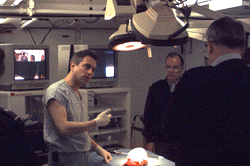

"Imagine a corpsman as far away as Bosnia making an emergency examination with this new device and sending the image via satellite to a doctor at Walter Reed Medical Center in Washington, D.C.," says Steve Carter, a UW clinical associate professor of radiology involved with the project.
While work on the hand-held diagnostic device is just getting under way, research on transmitting images and advice via telephone lines and satellites-- called "telemedicine"--has been under way for several years with money from the Department of Defense. A 1995 test proved that ultrasound images could be transmitted in a matter of seconds and cases discussed via satellite links between the UW Medical Center, ATL in Bothell, Madigan Army Medical Center in Tacoma and a community hospital in Ronan, Mont. Links to the UW Medical Center should, conceivably, work from anywhere in the Western Hemisphere.

The telemedicine work involves a team of researchers from the School of Medicine including Carter, Brent Stewart, Alan Rowberg, Tom Winter, William Shuman and Patrick Freeny. With satellite time provided by NASA, the team also included George Nelson from astronomy.
In non-emergency situations, telemedicine links and the new ultrasound instrument being developed by the UW and ATL could be used to diagnose everything from blood clots to kidney stones to pregnancy problems. Family practitioners, nurse practitioners and others could work via satellite or telephone with radiologists at distant facilities.
The new device dovetails closely with a $10 million defense-funded effort to use high-intensity, focused ultrasound to slow or halt bleeding when people suffer severe trauma, according to Crum. Until now, the emerging field of high-intensity ultrasound has concentrated on using sound waves to destroy unwanted tissue such as tumors. The approach has the advantage of being non-invasive -- patients don't have to go under the knife.
Physicians know that when high-intensity, focused ultrasound kills unwanted tissue, the blood in the surrounding area undergoes changes. During the next five years, Crum will lead UW researchers who hope to develop ultrasound technology that can stimulate coagulation.
"We're calling the process `acoustic hemostasis,' sound energy to arrest bleeding," Crum says. The team working on the project includes the School of Medicine's Carter, Kirk Beach and Roy Martin, as well as Crum and his colleagues at the Applied Physics Laboratory.
Defending the Environment with DOD Dollars
APL: Vietnam Era Target Is Now More Open
Cold War Inventions May Help Save the Earth
APL Home Page
Send a letter to the editor at columns@u.washington.edu.